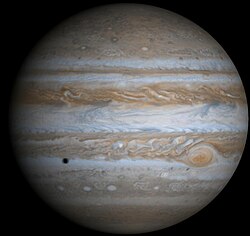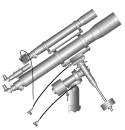Portal:Astronomie
Portal Astronomie Willkommen auf der zentralen Anlaufstelle zum Themenbereich der Astronomie in der Wikipedia! Für Fragen und Anregungen steht die Diskussionsseite zur Verfügung. Möglichkeiten zum aktiven Mitwirken bietet die Seite Mitarbeit. Viel Spaß! | |||||||||||||||||||||||||||||||||||||||||||
(bearbeiten, Archiv)
| (bearbeiten) Jupiter ist mit einem Äquatordurchmesser von rund 143.000 Kilometern der größte Planet des Sonnensystems. Mit einer durchschnittlichen Entfernung von 778 Millionen Kilometern ist er von der Sonne aus gesehen der fünfte Planet. Er ist nach dem römischen Hauptgott Jupiter benannt. Er hat keine sichtbare feste Oberfläche. Aufgrund seiner chemischen Zusammensetzung zählt Jupiter zu den Gasplaneten. Diese „Gasriesen“ bilden im Sonnensystem die Gruppe der äußeren Planeten; sie werden auch als jupiterähnliche (jovianische) Planeten bezeichnet. In dieser Gruppe ist Jupiter der innerste Planet; er läuft jenseits des Asteroidengürtels um die Sonne. 2018 waren 79 Monde des Jupiter bekannt. Die vier größten sogenannten Galileischen Monde Ganymed, Kallisto, Io und Europa haben Durchmesser zwischen 5262 und 3122 km und wurden bereits 1610 entdeckt. Jupiter ist das dritt- bis vierthellste Objekt des Nachthimmels (nach Mond und Venus; abhängig von der Bahnkonstellation ist bisweilen auch Mars heller). In Babylonien galt er wegen seines goldgelben Lichts als Königsstern (siehe auch Stern von Betlehem). Sein astronomisches Symbol ist ♃. | ||||||||||||||||||||||||||||||||||||||||||
(bearbeiten, alle Ereignisse)
| (bearbeiten, alle Bilder ansehen)  Marsvulkan Olympus Mons | ||||||||||||||||||||||||||||||||||||||||||
(bearbeiten, Archiv) Allgemeines: • 01.04. Exzentrizitätsvektor • 26.03. Kenneth Zeigler · The First Men in the Moon (Film, 1919) Individuelle astronomische Objekte: • 06.04. IC 1071 · IC 1072 · IC 1073 · IC 1074 · IC 1075 · IC 1076 · IC 1078 · IC 1079 · IC 1082 • 05.04. IC 1077 · IC 1080 · IC 1081 · IC 1083 · IC 1084 · IC 1110 • 03.04. IC 1091 · IC 1092 · IC 1093 · IC 1094 · IC 1095 · IC 1096 · IC 1097 • 02.04. IC 1058 · IC 1059 · IC 1060 · IC 1065 · Trappist-1 c • 01.04. (18241) Genzel · IC 1050 · IC 1051 · IC 1052 · IC 1053 · IC 1055 • 30.03. Gliese 486 • 29.03. PJ352–15 • 27.03. IC 1039 · IC 1040 · IC 1041 · IC 1043 · IC 1044 · IC 1046 · IC 1047 • 26.03. (3909) Gladys · (6854) Georgewest |
Einen Einstieg in die Vielfalt der Artikel aus dem Bereich Astronomie bietet sowohl der alphabetische Index als auch die hierarchische Gliederung, deren oberste Ebene hier auszugsweise erläutert wird. Die vollständige Übersicht der hierarchischen Gliederung enthält auch Hinweise zur Kategorisierung neuer Artikel. In der nachfolgenden Übersicht leiten die kursiven Links direkt zu Artikeln, die restlichen führen zu den jeweiligen Kategorien.
| ||||||||||||||||||||||||||||||||||||||||||
Commons: Astronomie – Sammlung von Bildern, Videos und Audiodateien Wikibooks: Regal Astronomie – Lern- und Lehrmaterialien Wikinews: Portal Astronomie – in den Nachrichten Wikiquote: Astronomie – Zitate Wikisource: Astronomie – Quellen und Volltexte | |||||||||||||||||||||||||||||||||||||||||||
| |||||||||||||||||||||||||||||||||||||||||||
Qualitätsprädikat: |
Auf dieser Seite verwendete Medien
Autor/Urheber: en:User:Cormullion., Lizenz: CC BY-SA 2.5
Original summary: "I drew this picture in Illustrator to illustrate the analog of the 24 hour dial".
This artist's conception shows a Jupiter-sized planet forming from a disk of dust and gas surrounding a young, massive star. The planet's gravity has cleared a gap in the disk. Of more than 500 stars examined in the W5 star-forming region, 15 show evidence of central clearing that may be due to forming planets. Image credit: David A. Aguilar, CfA
This is a mosaic image, one of the largest ever taken by NASA's Hubble Space Telescope, of the Crab Nebula, a six-light-year-wide expanding remnant of a star's supernova explosion. Japanese and Chinese astronomers recorded this violent event in 1054 CE.
The orange filaments are the tattered remains of the star and consist mostly of hydrogen. The rapidly spinning neutron star embedded in the center of the nebula is the dynamo powering the nebula's eerie interior bluish glow. The blue light comes from electrons whirling at nearly the speed of light around magnetic field lines from the neutron star. The neutron star, like a lighthouse, ejects twin beams of radiation that appear to pulse 30 times a second due to the neutron star's rotation. A neutron star is the crushed ultra-dense core of the exploded star.
The Crab Nebula derived its name from its appearance in a drawing made by Irish astronomer Lord Rosse in 1844, using a 36-inch telescope. When viewed by Hubble, as well as by large ground-based telescopes such as the European Southern Observatory's Very Large Telescope, the Crab Nebula takes on a more detailed appearance that yields clues into the spectacular demise of a star, 6,500 light-years away.
The newly composed image was assembled from 24 individual Wide Field and Planetary Camera 2 exposures taken in October 1999, January 2000, and December 2000. The colors in the image indicate the different elements that were expelled during the explosion. Blue in the filaments in the outer part of the nebula represents neutral oxygen, green is singly-ionized sulfur, and red indicates doubly-ionized oxygen.The typical atom symbol. In popular culture, it is also used as a symbol of space (see Googie architecture).
Autor/Urheber: David Vignoni / ICON KING, Lizenz: LGPL
Icon von Nuvola icon theme für KDE 3.x.
Caption from NASA: Like early explorers mapping the continents of our globe, astronomers are busy charting the spiral structure of our galaxy, the Milky Way. Using infrared images from NASA's Spitzer Space Telescope, scientists have discovered that the Milky Way's elegant spiral structure is dominated by just two arms wrapping off the ends of a central bar of stars. Previously, our galaxy was thought to possess four major arms.
This artist's concept illustrates the new view of the Milky Way, along with other findings presented at the 212th American Astronomical Society meeting in St. Louis, Mo. The galaxy's two major arms (Scutum-Centaurus and Perseus) can be seen attached to the ends of a thick central bar, while the two now-demoted minor arms (Norma and Sagittarius) are less distinct and located between the major arms. The major arms consist of the highest densities of both young and old stars; the minor arms are primarily filled with gas and pockets of star-forming activity.
The artist's concept also includes a new spiral arm, called the "Far-3 kiloparsec arm," discovered via a radio-telescope survey of gas in the Milky Way. This arm is shorter than the two major arms and lies along the bar of the galaxy.
Our sun lies near a small, partial arm called the Orion Arm, or Orion Spur, located between the Sagittarius and Perseus arms.Autor/Urheber: Peter Kemp (original) ; bayo (derivative), Lizenz: LGPL
Two books as an icon
This true-color simulated view of Jupiter is composed of 4 images taken by NASA's Cassini spacecraft on December 7, 2000. To illustrate what Jupiter would have looked like if the cameras had a field-of-view large enough to capture the entire planet, the cylindrical map was projected onto a globe. The resolution is about 144 kilometers (89 miles) per pixel. Jupiter's moon Europa is casting the shadow on the planet.
Autor/Urheber: Operarius, Lizenz: CC BY 3.0
Retouched version of de:Bild:Stonehenge, Salisbury.JPG, which has the following description: ---- Beschreibung = Stonehenge im Juli 2008 Quelle = selbst fotografiert Urheber = Operarius Datum = 24.07.2008
Autor/Urheber:
- Planeten: NASA, freigegeben
- Topografische Karte des Mars: NASA, freigegeben
- MIR im Orbit: NASA, freigegeben
- Levi Schleifenförmige Gasfilamente auf der Sonne: NASA/TRACE, freigegeben
Cover des Wikipress-Bandes Sonnensystem.
Autor/Urheber: perfectska04, GNOME icon artists, Lizenz: GPL
An icon from the GNOME-colors 5.5.1 icon theme
A composite Viking orbiter image of Olympus Mons on Mars, the tallest known volcano and mountain in the Solar System.
Autor/Urheber: Everaldo Coelho and YellowIcon;, Lizenz: LGPL
Ein Icon aus dem Crystal Clear-Thema
Autor/Urheber: Fred the Oyster, Lizenz: CC BY-SA 4.0
Equatorial-mounted Keplerian telescope.
Autor/Urheber:
- Astronomy_Amateur_3_V2.jpg: User Halfblue on en.wikipedia
- derivative work: Dirk Hünniger (talk)
Cover for the German Introductory Textbook on Astronomy.
The Cosmic Microwave Background temperature fluctuations from the 5-year Wilkinson Microwave Anisotropy Probe data seen over the full sky. The average temperature is 2.725 kelvins (degrees above absolute zero; absolute zero is equivalent to −273.15 °C or −459 °F), and the colors represent the tiny temperature fluctuations, as in a weather map. Red regions are warmer and blue regions are colder by about 0.0002 degree.
Autor/Urheber: Anne-Marie Mahfouf? Oxygen team?, Lizenz: GPL
Skalierbares High-Color-Programmsymbol im Oxygen-Stil für die Planetarium-Anwendung KStars aus der KDE Software Compilation.
Autor/Urheber: PlanetUser, Lizenz: CC BY-SA 4.0
This is a icon for Celestia reworked by FarGetaNik.
Eine wohl errechnete (simulierte – und zudem künstlerisch nachbearbeitete) Darstellung des Quasars GB 1508+5714.
Autor/Urheber: Xander, Lizenz: CC BY-SA 3.0
A modified version of calendar Tango! icon



































